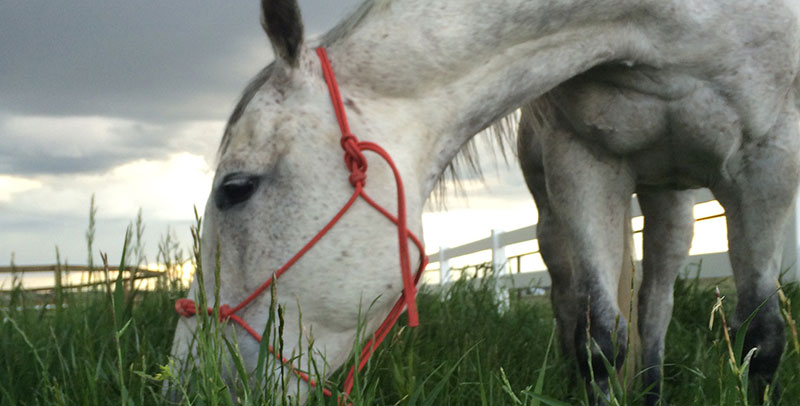
Grazing
Dryland Pasture Condition Assessment & Guidelines
Maintaining healthy dryland small acreage pastures can be challenging in Colorado, but it is a realistic goal. This guide will help pasture managers assess pasture condition and offer suggestions for improvements. Key strategies, such as determining carrying capacity, implementing rotational grazing, using indicator grasses to monitor when to start and stop grazing, and keeping grazing records, will help improve pasture health and production. Learn More
Too many weeds and not enough grass?
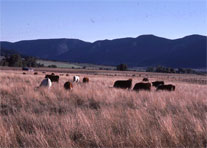
Proper grazing techniques can produce greener and more forageable pastures or rangeland. This simple technique involves allowing grass time to regrow between grazing intervals, and avoiding overgrazing. Pasture management will reduce weeds by maintaining healthy vegetation. The roots of the desired forbs, grasses and shrubs will out-compete weeds.
Why will grazing management produce more forage?
| Animals will seek out the most palatable forage in a pasture. If animals are allowed to continuously graze an area, they will re-graze and re-graze the most palatable and succulent re-growth rather than eating more mature plants. Eventually, the most valued grasses will disappear and undesirable weeds will flourish. |  A continuously grazed dryland pasture versus a managed dryland pasture |

Continuous grazing is hard on plants, using up their root reserves and slowing their recovery. This picture shows how grass roots are affected by overgrazing. The plant on the right has been continuously grazed while the plant on the left has been grazed for a short period and allowed to recover and regrow for a longer period.
General Grazing Guidelines
Realize that the amount of forage animals eat can not exceed half of the plant production in your pasture. Keep animals in a barn or in a small sacrifice area. Only allow limited grazing and exercise time in the pasture to reduce overgrazing. Try these simple grazing management techniques for healthier grass:
- Learn about the dominant forbs, grasses, and shrubs in your pasture or rangeland. Determine if the plants are warm or cool season. Cool season grasses grow in the spring and fall, while warm season grasses grow in the heat of the summer.
- Graze for short periods of time (7-10 days) and allow long re-growth periods (70-120 days) where the grass has time to recover with no grazing stress. Designate a small sacrifice area or corral to keep animals while grasses are recovering.
- Allow grass to reach the proper height in inches before grazing. This will enable your grass to build strong roots for vigorous photosynthesis and growth. Click here to learn more about proper grazing heights for specific forage species.
- Know when to remove your animals from an area. A rule of thumb is Take Half Leave Half. Never allow the grass to be grazed below a protective height.
- If you have limited acres of pasture, always supplemental feed before putting animals on pasture. This will reduce the amount of pasture plants eaten.
- Walk your pastures and monitor grass growth. Be flexible. Temperature and precipitation will vary from year to year, as will grass recovery time.
- Develop a grazing plan with help from your local NRCS and CSU Extension.
How can I make the most of my pasture or rangeland?
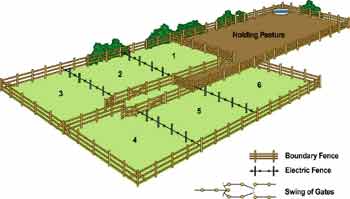 Establishing a rotational grazing system will allow you to make the most of your grass. Rotational grazing is defined as a practice in which 2 or more pastures are alternately rested and grazed in a planned sequence. The system at an intensive management level provides 70-120 days of rest periods followed by 7-10 days of grazing. Temporary fencing can be set-up to create smaller paddocks within a large pasture. Ten or more pastures are recommended per heard to create a high-intensity system.
Establishing a rotational grazing system will allow you to make the most of your grass. Rotational grazing is defined as a practice in which 2 or more pastures are alternately rested and grazed in a planned sequence. The system at an intensive management level provides 70-120 days of rest periods followed by 7-10 days of grazing. Temporary fencing can be set-up to create smaller paddocks within a large pasture. Ten or more pastures are recommended per heard to create a high-intensity system.
Rangeland carrying capacity app
This tool is was developed to help land managers estimate the carrying capacity of their land. Forage production estimates were obtained from the rangelands.app and SSURGO datasets. This tool is not meant to replace on the ground forage assessments but can provide some insight into how many animals can be grazed on a field and for how many days.
Visit this link to get started.
Paddock Paradise Track System for Horses
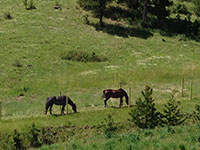
A simple track system known as “paddock paradise” can be created on small acreage pastures to allow horses space for exercise while protecting your pasture grasses. Learn more.
Poisonous Plants
Poisonous plants are common in Colorado’s pasture and range and generally are avoided by livestock. However, there are situations where livestock poisoning is more likely to occur.
- Lack of other forage to eat because of an overgrazed pasture or a dry year.
- Animals are new to the area (from another state where they are not trained to avoid certain plants).
- Animals are grazing in snow cover and the only plants sticking up from the snow are poisonous.
- Dose makes the poison (livestock usually need to eat a lot to be poisoned).
Poisonous Plant Resources:
Knight, A., Walter, R. (2001). A Guide to Plant Poisoning of Animals in North America. Teton New Media: Jackson, Wyoming. A comprehensive book of poisonous plants in Colorado.
Guide to Poisonous Plants website – search by plant name or clinical sign.
Plants Poisonous to Livestock in the Western States – A description of more than 30 of the principal poisonous plants growing on western ranges and the signs of poisoning in livestock.
Reseeding
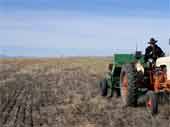
- If you currently have a pasture or rangeland in poor condition, before thinking about replanting first consider invigorating your land with the grazing management guidelines listed above and weed control. The average cost for reseeding is $200-$400 per acre so it pays to adjust management practices first.
- General Guidelines for Reseeding on Small Acreages in Colorado.
- Contact your local NRCS and CSU Extension office to determine the appropriate seed mixtures and seeding methods for your area and soil type. You can also find seed mixes listed in Appendix A of the Colorado Forage Guide
- Find local contractors and seed dealers on the Small Acreage Services Database.
Native Plant Revegetation Guide for Colorado. Colorado Natural Areas Program
A comprehensive resource for native restoration
SAM Newsletter Articles on Reseeding
- Thinking of Reseeding a Pasture? – fall 2019
- Basics of Dryland Grass Establishment – winter 2010
- Cover Crops Help in Dryland Grass Establishment – winter 2012
- Establishing Sustainable Grasses on – fall 2015
- General Grass Seeding Plan for Dryland Areas – fall 2013
- Going Native – summer 2011
- Grass Seeding – fall 2012
- No-Till Grass Drill – summer 2013
- Pasture Grasses – fall 2010
SAM Webinars on Reseeding
Forage Guides
Colorado Forage Guide
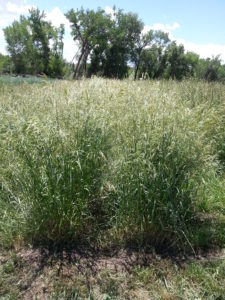 Produced to help small acreage landowners become familiar with livestock forage and grazing management. Information is provided on how grasses differ, what legumes are and how they can fit into pastures, and what to consider if you need to revegetate your pasture, including how to design your own seed mix. The section on grazing management will help you know what to look for and expect before, during, and after your pastures are grazed. Because grazing is an ongoing learning process, this information will complement your own experiences and the advice of others, such as Colorado State University Extension (CSU Extension), the Natural Resources Conservation Service (NRCS), and neighbors. Download guide.
Produced to help small acreage landowners become familiar with livestock forage and grazing management. Information is provided on how grasses differ, what legumes are and how they can fit into pastures, and what to consider if you need to revegetate your pasture, including how to design your own seed mix. The section on grazing management will help you know what to look for and expect before, during, and after your pastures are grazed. Because grazing is an ongoing learning process, this information will complement your own experiences and the advice of others, such as Colorado State University Extension (CSU Extension), the Natural Resources Conservation Service (NRCS), and neighbors. Download guide.
Intermountain Grass and Legume Forage Production Manual – This manual has in-depth research based information that you can use to improve your management of grass or alfalfa dominated pastures and hayfields.
Grasses and Grass like plants (from USU) – A great resource to help identify the species of grasses on your land.
Resources
Resources & Helpful Information
Society of Range Management – Find information about management practices, certifications, rangeland professionals, events and more.
Bureau of Land Management – Information about public land grazing management strategies, standards and regulations.
SAM Webinars and Web Videos
- Biological Weed Control for Colorado Landowners
- Common Forage Grasses
- Integrated Weed Management
- Maximizing Irrigated Pasture Productivity
- Pasture Management During and After Drought
- Pasture Management on Small Acreages
- Poisonous Plants and Horses
- Poisonous Plants of Colorado
- Understanding Soil
- How Grass Grows – 3 minute video on grass and grazing
- Pasture Management Strategies – 3 minute video on pasture management
- Landowner shares his experience with pasture management. Watch now.
More Videos
University of Wyoming presents some basic principles of good grazing management that will help keep your cool season grass pastures healthy.
Sampling on Small Acreages
SAM Newsletter Articles
- Thinking of Reseeding a Pasture? – fall 2019
- Plant Look-a-Likes: Hemlock and Osha – fall 2019
- Rangeland Grass Recovery After Drought – summer 2019
- Animal Grazing Habits – winter 2010
- Cheatgrass Increases Fire Risk – summer 2013
- Drought Calls for Change in Grazing – winter 2013
- Early Weed Detection for Better Management – winter 2011
- Fall Irrigation for Cool Season Grasses – summer 2011
- Fall Pasture Management – summer 2009
- First Steps to Identifying Grasses on Your Property – spring 2013
- Grass Tidbits – summer 2010
- Grasses and Growth Cycles – spring 2015
- Grasshoppers –spring 2012
- High Nitrates in Drought Stressed forage – fall 2012
- How to Assess Hay for Quality – fall 2012
- Manage Cheatgrass This Winter – winter 2014
- Pasture Use and Rotational Grazing Systems – spring 2010
- Temporary Fencing – winter 2009
- Winter Grazing – winter 2012




